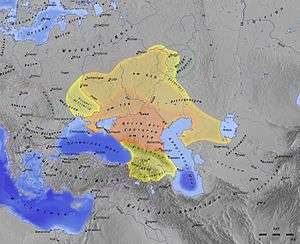Arsiyah
Arsiyah (other forms of the word include al-Arsiyya, al-Arsiya, As-yah, al-Ursiyya, al-Larisiya, al-Orsiyya, Aorsi and Ors) was the name used for a group of Muslim mercenaries in the service of the Khazar Khaganate. Whether the Arsiyah were a single tribe or composed of Muslims from a number of different tribes is unclear. Also unclear is their origin; many historians regard them as deriving from Khwarazm, but some scholars point to the fact that "As" is the Turkic term for Alans and believe that the Arsiyah were Alanic in origin. Other scholars derive the name from Iranian Auruša (white).[1]
According to Muslim sources, the Arsiyah formed the core of the Khazar army and were extremely influential in Khazar politics, but these assertions may be designed to exaggerate the importance of the Muslim community in Khazaria. The Arsiyah did often act independently of their government. Part of the treaty binding them to Khazar service guaranteed that they would not be used to fight other Muslims. In 913, the Arsiyah ambushed a Varangian fleet that had been granted passage to the Caspian Sea by the Khazar government, wiping out thousands of Rus warriors.
Notes
- Golden 2007, p. 138, note 82.
References
- Peter B. Golden. "The Conversion of the Khazars to Judaism." The World of the Khazars: New Perspectives. Leiden: Brill, 2007.
- Kevin Alan Brook. The Jews of Khazaria. 2nd ed. Rowman & Littlefield Publishers, Inc, 2006.
- Douglas M. Dunlop. The History of the Jewish Khazars. Princeton, N.J.: Princeton University Press, 1954.
- Norman Golb and Omeljan Pritsak. Khazarian Hebrew Documents of the Tenth Century. Ithaca: Cornell University Press, 1982.
